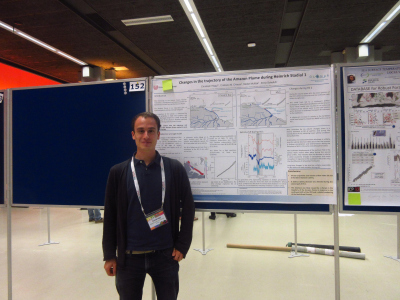Die Inhalte dieser Seite sind leider nicht auf Deutsch verfügbar.
Seitenpfad:
Christoph Häggi
Report of GLOMAR PhD student Christoph Häggi about his participation in the International Conference on Paleoceanography in Utrecht, Netherlands from 29 August - 2 September 2016
Thanks to funding by GLOMAR graduate school, I was able to attend the International Conference on Paleoceanography (ICP) 12 in Utrecht, the Netherlands, from August 28th to September 2nd 2016. The ICP is a triennial meeting of paleoceanographers from around the world and its 12th edition took place in the Beatrix Theather close to Utrecht Central Station. Traditionally, the conference was held in a unique format featuring 20 invited speakers that presented their research in half hour presentation to the plenum during the mornings. The rest of the over 600 attending scientists were able to present posters in the afternoons. The daily program was concluded by a perspective lecture held by distinguished figure in the field.
The research presented at ICP12 featured paleoceanographic studies based on paleoproxies data, as well as numerous modelling studies. The majority of paleoproxy studies focused on reconstruction using foraminifera, but there were also presentations and posters featuring research on other proxies such as biomarkers, pollen or dinoflagellates. The most commonly discussed time ranges were the Pleistocene and Pliocene and there was also a heavy focus on the processes surrounding the Eocene- Oligocene boundary.
Personally, I contributed to the conference by presenting a poster on changes in trajectory of the Amazon Plume in response to Heinrich event 1. On the one hand, I presented results of a calibration study for a novel salinity proxy based on the stable hydrogen isotope composition of palmitic acid. On the other hand, I presented a down core salinity reconstruction using this proxy, which indicated strong salinity changes during Heinrich event 1. Since there were other scientists presenting new foraminifera based salinity data from close by cores in the tropical Atlantic, my poster led to interesting discussions, which further increased my understanding of the course of events during Heinrich events in the tropical Atlantic Ocean.
In conclusion, the ICP12 gave an interesting insight into the current developments in paleoceanography. Apart from providing me with an update on the paleoclimate research of the late Pleistocene, it also offered an interesting perspective of the research conducted on other time scales.
The research presented at ICP12 featured paleoceanographic studies based on paleoproxies data, as well as numerous modelling studies. The majority of paleoproxy studies focused on reconstruction using foraminifera, but there were also presentations and posters featuring research on other proxies such as biomarkers, pollen or dinoflagellates. The most commonly discussed time ranges were the Pleistocene and Pliocene and there was also a heavy focus on the processes surrounding the Eocene- Oligocene boundary.
Personally, I contributed to the conference by presenting a poster on changes in trajectory of the Amazon Plume in response to Heinrich event 1. On the one hand, I presented results of a calibration study for a novel salinity proxy based on the stable hydrogen isotope composition of palmitic acid. On the other hand, I presented a down core salinity reconstruction using this proxy, which indicated strong salinity changes during Heinrich event 1. Since there were other scientists presenting new foraminifera based salinity data from close by cores in the tropical Atlantic, my poster led to interesting discussions, which further increased my understanding of the course of events during Heinrich events in the tropical Atlantic Ocean.
In conclusion, the ICP12 gave an interesting insight into the current developments in paleoceanography. Apart from providing me with an update on the paleoclimate research of the late Pleistocene, it also offered an interesting perspective of the research conducted on other time scales.



